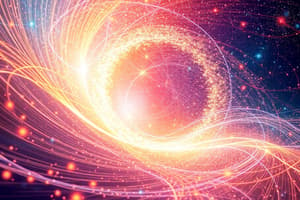Podcast
Questions and Answers
Which of the following phenomena is explained by the wave nature of light?
Which of the following phenomena is explained by the wave nature of light?
- Photoelectric effect
- Traveling in a straight line
- Casting shadows of objects
- Reflection, refraction, diffraction (correct)
Light always exhibits wave-like properties.
Light always exhibits wave-like properties.
False (B)
What is the term used to describe the mixture of particles (photons) that light is composed of?
What is the term used to describe the mixture of particles (photons) that light is composed of?
Electromagnetic wave
The particle nature of light explains how light travels in a ______ line.
The particle nature of light explains how light travels in a ______ line.
Match the following phenomena with the property of light that explains them:
Match the following phenomena with the property of light that explains them:
What is the unique property of light that allows it to exhibit both wave-like and particle-like behavior depending on the situation?
What is the unique property of light that allows it to exhibit both wave-like and particle-like behavior depending on the situation?
What phenomenon can be explained by the wave nature of light, but not by its particle nature?
What phenomenon can be explained by the wave nature of light, but not by its particle nature?
How does the particle nature of light explain the phenomenon of casting shadows of objects?
How does the particle nature of light explain the phenomenon of casting shadows of objects?
What is an example of a phenomenon that can be explained by both the wave and particle nature of light?
What is an example of a phenomenon that can be explained by both the wave and particle nature of light?
What is the term used to describe the phenomenon where light exhibits both wave-like and particle-like behavior, depending on the situation?
What is the term used to describe the phenomenon where light exhibits both wave-like and particle-like behavior, depending on the situation?
Flashcards are hidden until you start studying
Study Notes
Properties of Light
- Light exhibits dual nature, behaving as both an electromagnetic wave and a mixture of particles (photons) simultaneously.
- The wave nature of light explains various phenomena, including:
- Reflection
- Refraction
- Diffraction
- The particle nature of light explains:
- Light traveling in a straight line
- The phenomenon of casting shadows of objects
- The photoelectric effect
Properties of Light
- Light exhibits dual nature, behaving as both an electromagnetic wave and a mixture of particles (photons) simultaneously.
- The wave nature of light explains various phenomena, including:
- Reflection
- Refraction
- Diffraction
- The particle nature of light explains:
- Light traveling in a straight line
- The phenomenon of casting shadows of objects
- The photoelectric effect
Studying That Suits You
Use AI to generate personalized quizzes and flashcards to suit your learning preferences.




